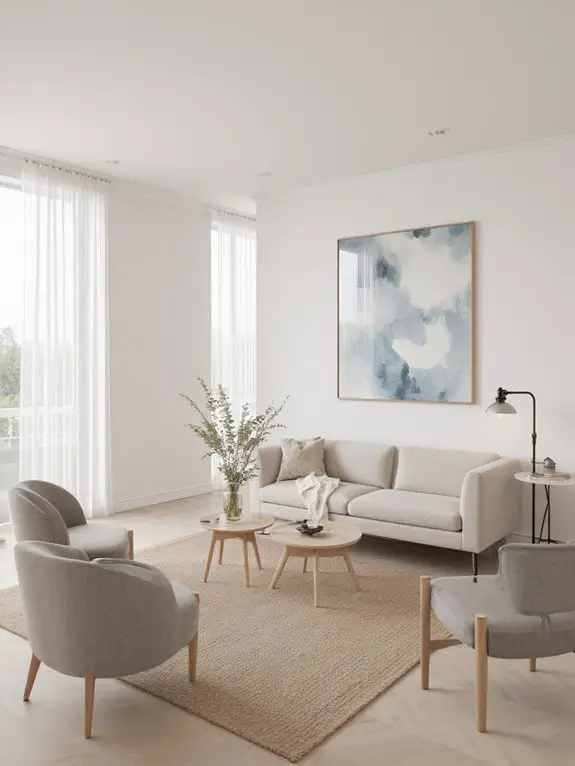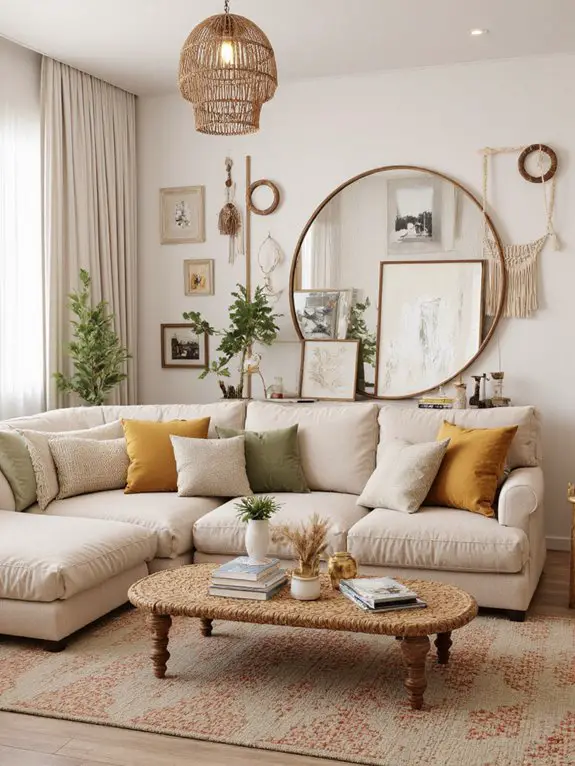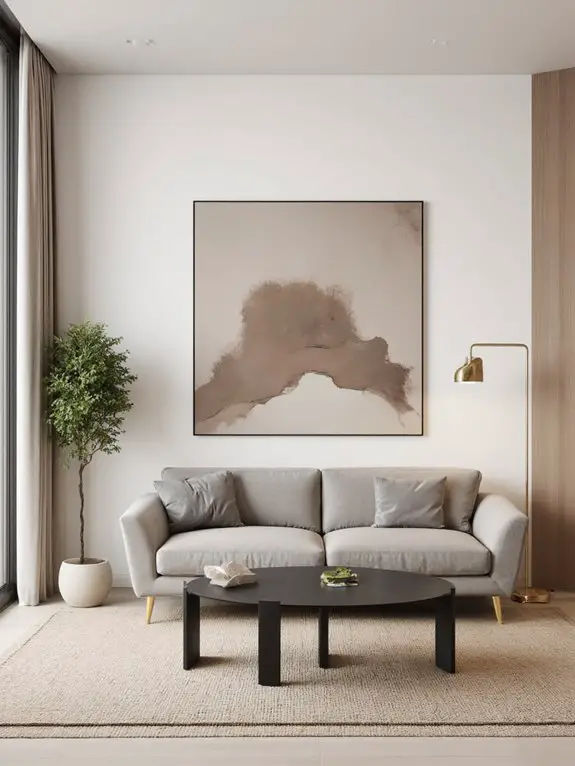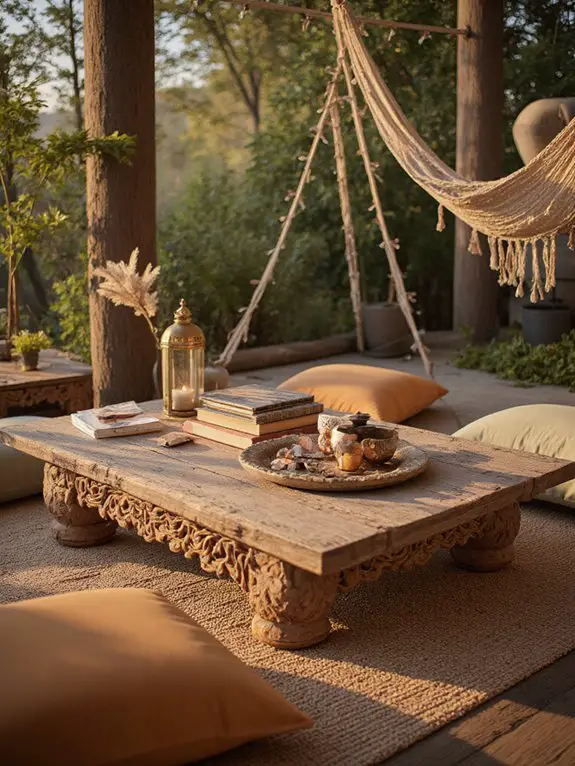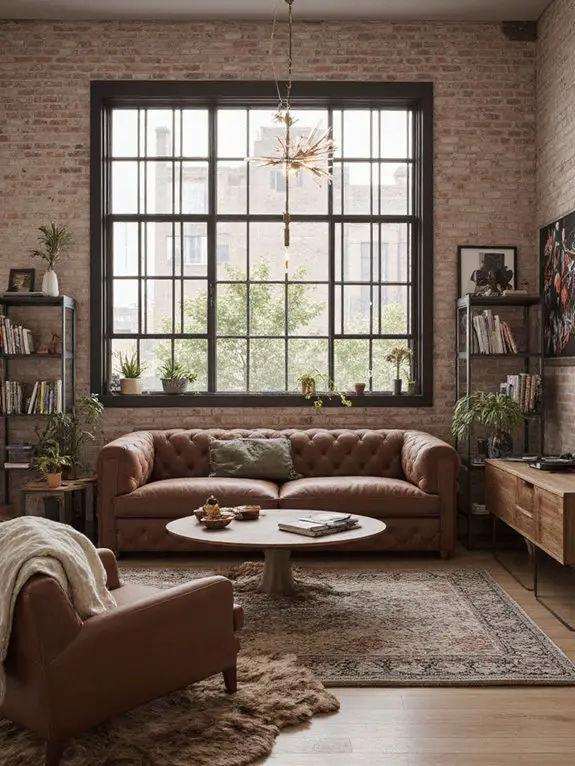Interior design styles offer unique aesthetics tailored to different tastes. Traditional interiors embrace timeless elegance with rich woods and symmetry, while modern design focuses on clean lines and minimalist functionality. Contemporary blends current trends with warmth, using bold accents and sleek furniture. Minimalist spaces prioritize openness and simplicity, and Scandinavian design combines functionality with cozy, natural materials. Each style reflects distinct principles, letting you create spaces that resonate with your lifestyle. Exploring further reveals even more inspiring options to transform your home.
Traditional
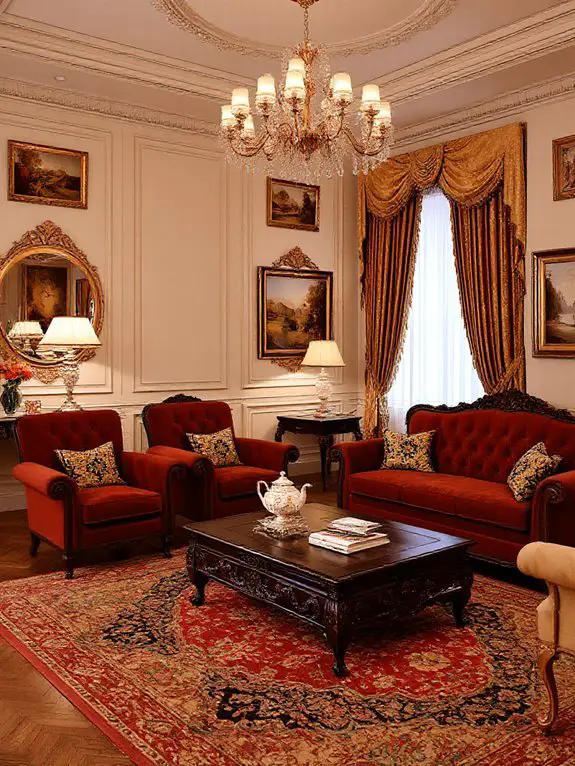
When I think of traditional interior design, I imagine spaces that exude timeless elegance and comfort. It’s about embracing classic elements like rich woods, ornate moldings, and luxurious fabrics.
I’d recommend starting with neutral tones like beige or cream, then layering in deeper hues such as burgundy or navy for depth. Symmetry is key—think matching armchairs or balanced art placements.
I love incorporating antiques or heirlooms to add personality and history. Quality over quantity is my mantra; invest in well-crafted furniture that lasts.
Traditional design isn’t about being outdated; it’s about creating a warm, inviting space that feels like home.
Modern
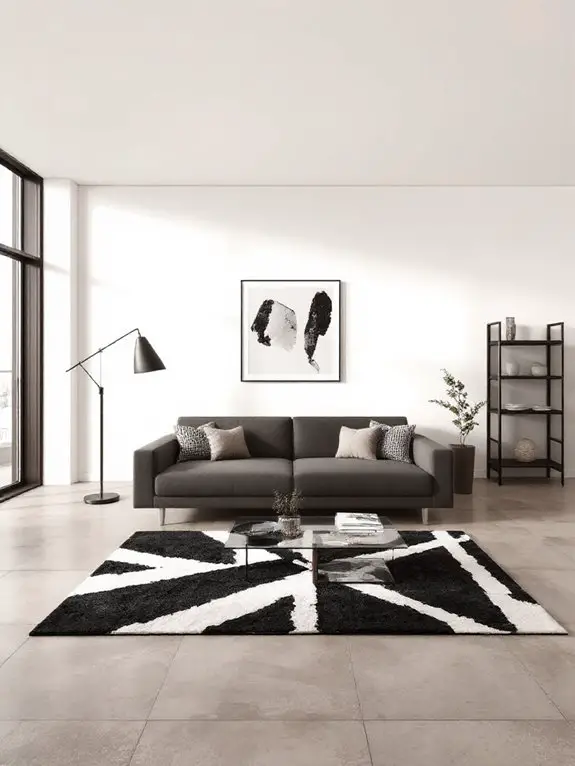
While traditional design embraces ornate details, modern interior design thrives on simplicity and minimalism. I focus on clean lines, neutral color palettes, and open spaces to create a sense of calm and order.
I often use materials like glass, steel, and concrete, which highlight functionality while maintaining elegance. Furniture in modern design is sleek and unadorned, with an emphasis on form and purpose.
I avoid clutter, opting for thoughtfully curated decor. Natural light plays a key role, so I incorporate large windows or strategic lighting. Modern design feels timeless, offering a fresh yet enduring aesthetic that suits lifestyles valuing clarity and efficiency.
Contemporary
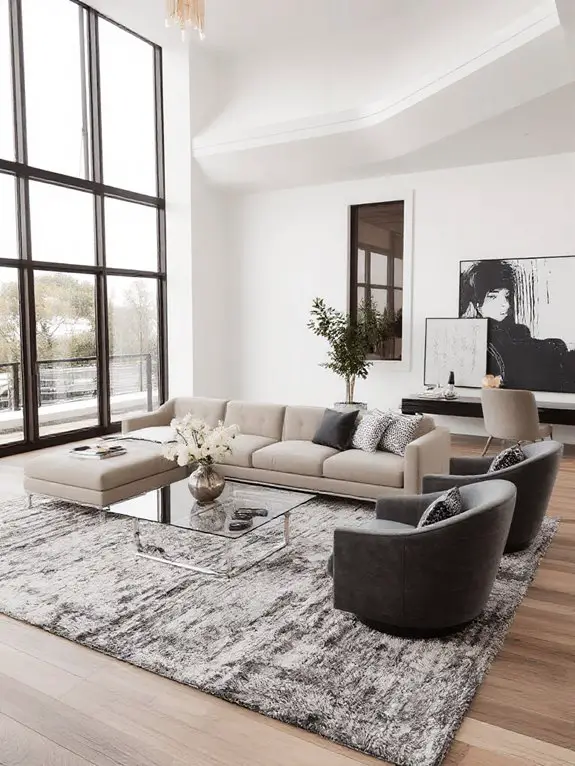
Contemporary interior design reflects the trends of today, embracing the fluidity of styles and preferences. I love how it blends clean lines with warmth, creating spaces that feel both current and inviting.
Focus on neutral color palettes with bold accents—think grays, whites, or taupes paired with vibrant art or metallic finishes. I’d recommend incorporating natural materials like wood or stone to add texture.
Furniture should be sleek yet comfortable, with an emphasis on functionality. Lighting plays a key role; I prefer statement fixtures that double as art.
The beauty of contemporary design lies in its adaptability—it’s always evolving, just like us.
Minimalist
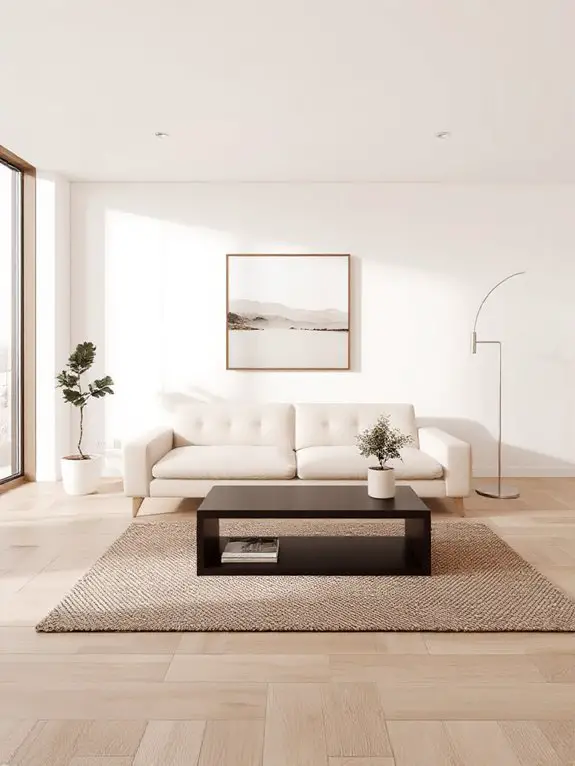
Since simplicity is the cornerstone of minimalist design, I approach it by focusing on essentials and eliminating excess. I start with a neutral color palette—whites, grays, and earth tones—to create a serene atmosphere.
Clean lines and uncluttered spaces are non-negotiable; I choose furniture with sleek, functional designs. Multi-purpose pieces, like storage ottomans or modular shelves, maximize utility without overcrowding.
I avoid decorative items unless they serve a purpose or evoke meaningful emotion. Lighting is key—I opt for natural light and simple fixtures.
Minimalism isn’t about emptiness but curating a space that feels intentional, calm, and deeply personal.
Scandinavian
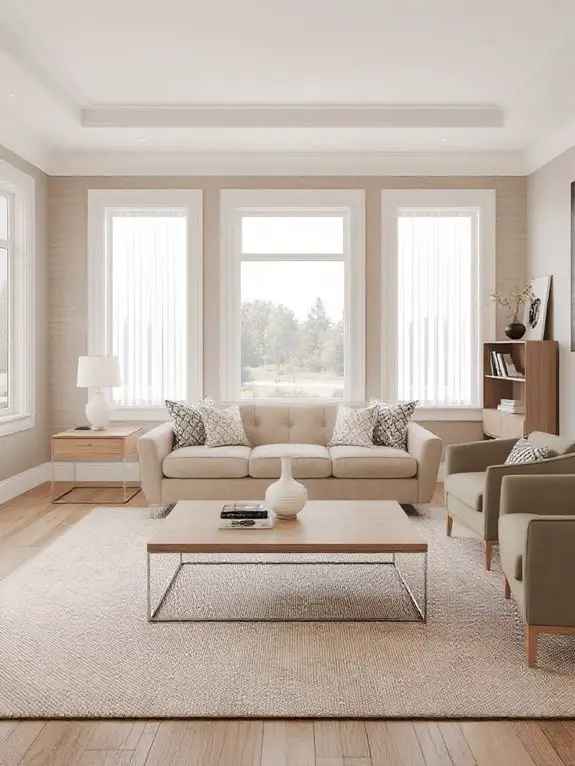
Inspired by the Nordic lifestyle, I approach Scandinavian design by blending functionality, simplicity, and warmth. I prioritize clean lines, uncluttered spaces, and natural materials like wood and wool to create a cozy yet practical environment.
A neutral color palette—soft whites, grays, and muted tones—forms the foundation, often accented with pops of color through textiles or decor. I incorporate plenty of natural light to enhance the airy feel and use layered textures to add depth and comfort.
Every piece I choose serves a purpose, ensuring the space feels both inviting and efficient, embodying the essence of Scandinavian living.
Industrial
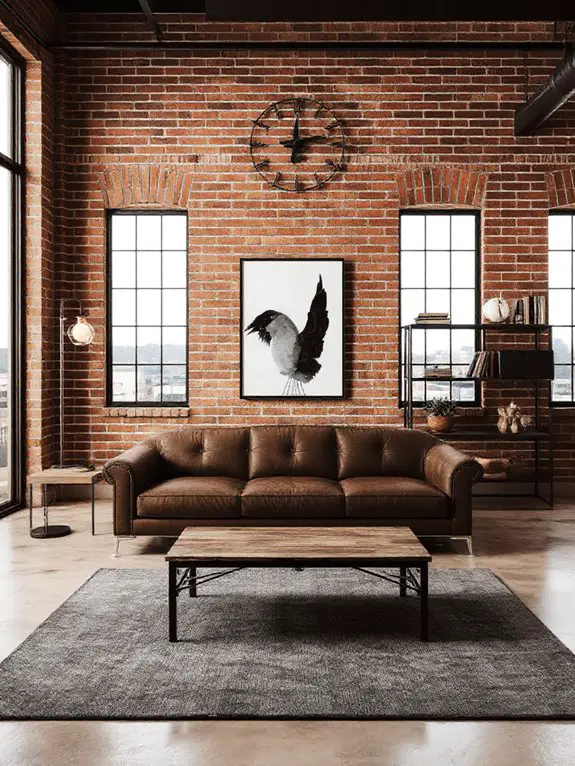
Industrial design draws from the raw, unfinished aesthetics of factories and warehouses, emphasizing exposed elements and rugged materials. Think exposed brick walls, metal beams, and concrete floors.
Honestly, I’d recommend incorporating reclaimed wood and wrought iron for furniture pieces to keep things authentic. Open layouts are key, so that everything feels spacious and functional.
My go-to for lighting? Industrial-style fixtures like Edison bulbs and pendant lights. Stick to neutral tones like gray, black, and brown, with occasional pops of color for contrast.
Mid-Century Modern
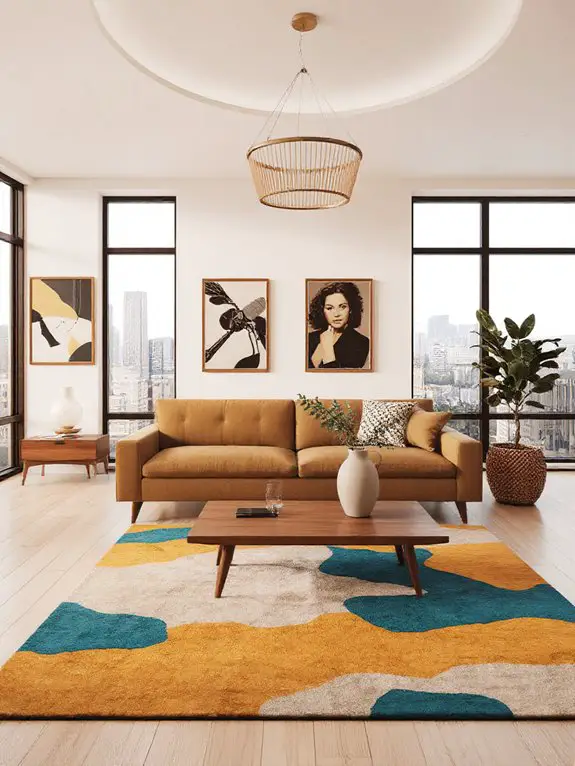
While Mid-Century Modern design originated in the mid-20th century, its timeless appeal continues to influence interiors today. I love its clean lines, organic curves, and functional yet stylish approach.
When designing in this style, I focus on simplicity—think sleek furniture with tapered legs and minimal ornamentation. Natural materials like wood and leather are essential, paired with pops of bold color or geometric patterns.
Symmetry and open layouts create a sense of balance, while iconic pieces like Eames chairs add character. I always aim to blend form and function, ensuring the space feels both inviting and purposeful.
Mid-Century Modern is effortlessly chic and enduring.
Bohemian
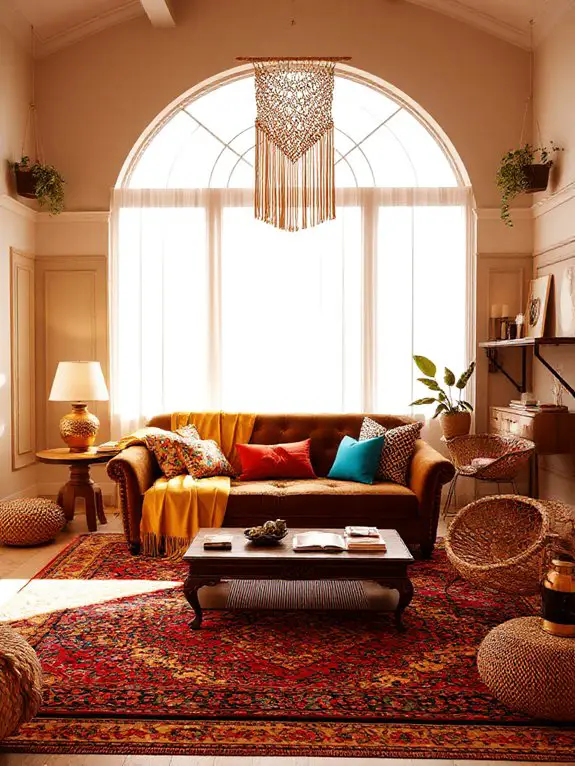
Bohemian design, often rooted in a free-spirited and eclectic aesthetic, embraces individuality and creativity through its layered textures, vibrant colors, and global influences. I love how it lets me mix patterns, like pairing floral prints with geometric designs, and incorporate bold hues like deep purples, rich oranges, and earthy greens.
Natural materials like rattan, jute, and wood are key, adding warmth and texture. I’m drawn to vintage or handmade pieces, which give the space a personal, lived-in feel.
Layering rugs, throw pillows, and blankets creates coziness, while plants bring life and freshness. It’s all about expressing your unique story through your surroundings.
Rustic
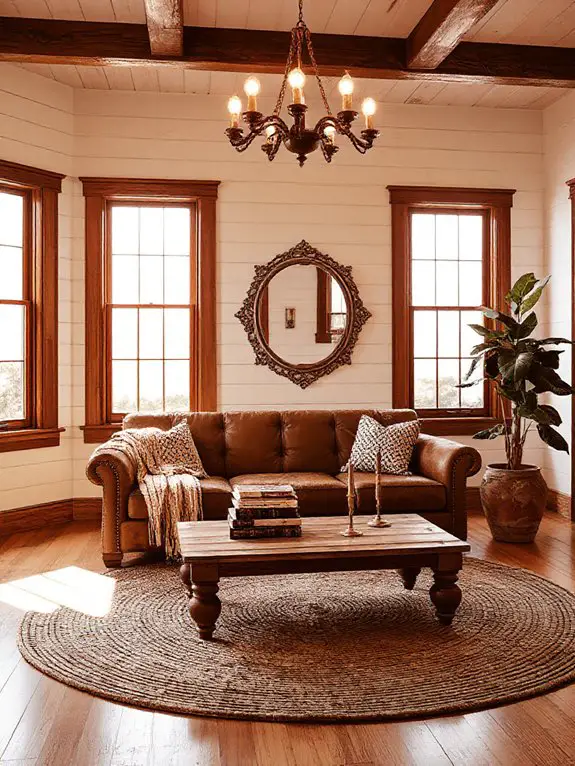
Rustic design captures the raw, natural beauty of the countryside, focusing on simplicity, rugged textures, and organic elements. I love how it celebrates imperfections, like weathered wood, exposed beams, and stone surfaces, creating a warm, lived-in atmosphere.
To achieve this look, I incorporate earthy colors such as browns, greens, and grays, paired with natural materials like leather, wool, and jute. Handcrafted furniture and vintage pieces add character, while cozy textiles like chunky knit throws enhance comfort.
Lighting is key—I opt for wrought iron chandeliers or lanterns to evoke a timeless charm. Rustic design feels grounding, connecting me to nature’s authenticity.
Farmhouse
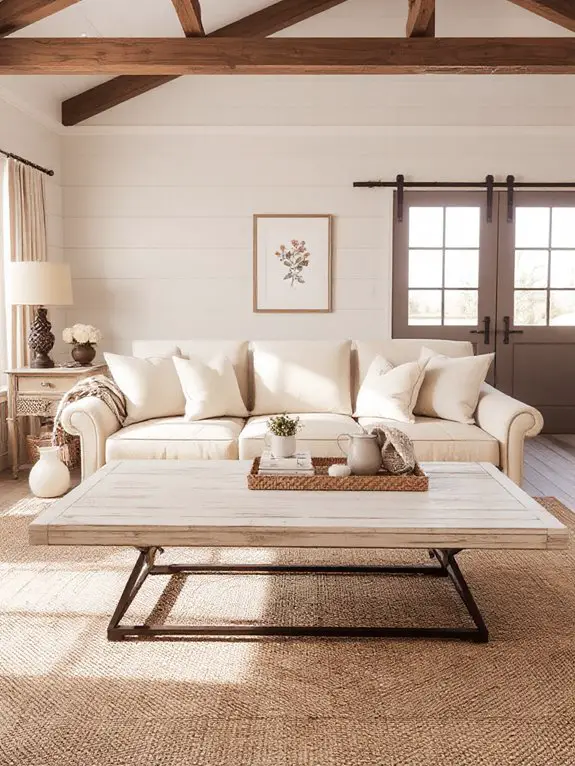
Farmhouse style blends cozy comfort with practical simplicity, creating a welcoming space that feels both lived-in and intentional. I love how it combines rustic charm with clean lines, using natural materials like wood, metal, and stone.
Neutral color palettes with soft whites, creams, and grays dominate, while textures like linen and burlap add depth. Open shelving, farmhouse sinks, and shiplap walls are staples that evoke a timeless appeal.
I often incorporate vintage or handmade items to enhance authenticity. The key is balance—keeping the space uncluttered but warm, making it perfect for gathering and everyday living.
Coastal
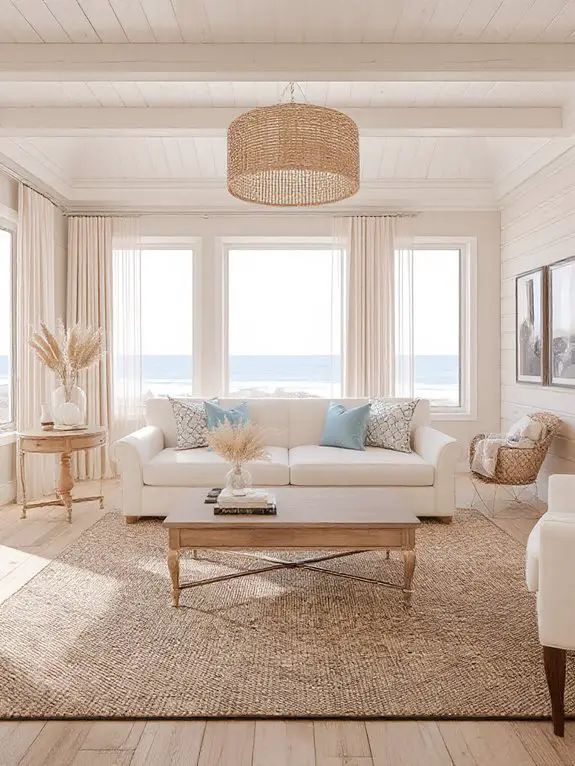
When I think of coastal design, I immediately envision a space that feels light, airy, and inspired by the sea, blending natural elements with relaxed elegance. I focus on a neutral palette of whites, blues, and sandy beiges to evoke the shoreline. Natural textures like rattan, jute, and weathered wood are essential to create that breezy, lived-in vibe.
I incorporate subtle nautical accents, such as stripped patterns or seashell decor, but keep it understated to avoid kitsch. Large windows and sheer fabrics maximize natural light, while layered linens and soft furnishings guarantee comfort.
The result is a serene, timeless retreat.
Shabby Chic

Though it may seem effortlessly undone, shabby chic design is a carefully curated blend of vintage charm and soft elegance. I love how it combines worn, distressed furniture with pastel hues and floral patterns to create a cozy, lived-in feel.
Key elements include whitewashed wood, antique décor, and soft linens that evoke a sense of nostalgia. I often layer textures like chipped paint, weathered wood, and plush fabrics to add depth.
Lighting plays a role too—I opt for crystal chandeliers or vintage lamps to balance the casual vibe. It’s a style that feels timeless yet intentionally imperfect, inviting warmth and history into any space.
Art Deco
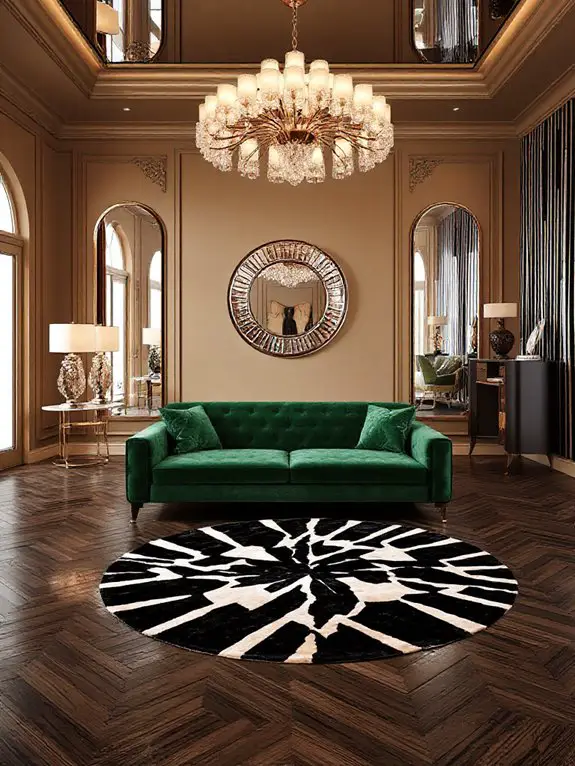
Art Deco captivates with its bold geometric shapes, luxurious materials, and streamlined elegance. I love how it combines symmetry with opulence, using materials like lacquer, chrome, and marble to create a sense of grandeur.
The style’s clean lines and repetitive patterns evoke a feeling of modernity, while rich colors like deep blues, emerald greens, and gold add drama. I often incorporate Art Deco-inspired furniture with sleek curves and metallic finishes to anchor a space.
Mirrors with angular frames and bold lighting fixtures are also essential. This style works beautifully in living rooms, bedrooms, or even bathrooms, offering timeless sophistication.
Transitional
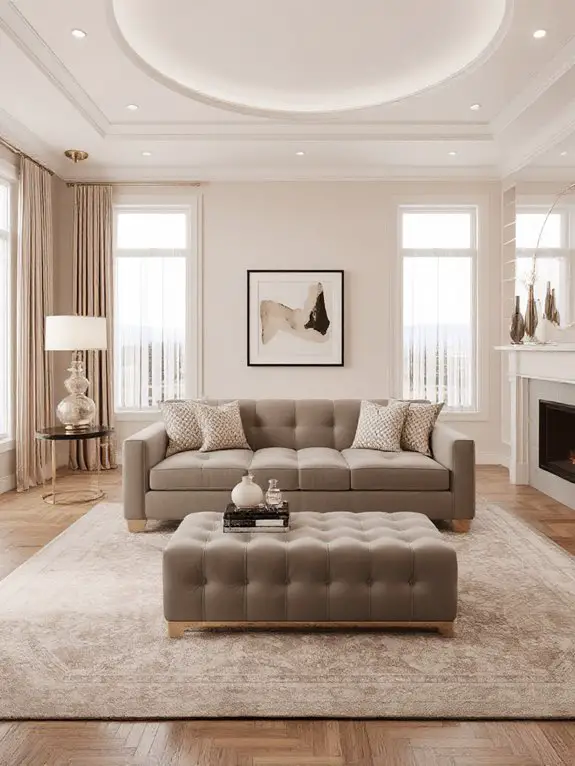
Evolving design blends traditional and contemporary elements, creating a harmonious balance that’s both timeless and adaptable. I love transformative style because it avoids extremes—think neutral palettes with subtle pops of color, clean lines softened by textured fabrics, and furniture that merges classic shapes with modern finishes.
It’s perfect if you crave sophistication without rigidity. I recommend mixing a sleek sofa with a traditional wooden coffee table or pairing a modern chandelier with antique-inspired side tables.
The key is balance: too much tradition feels stuffy, while too much modernity lacks warmth. Layer textures like linen, leather, and metal to add depth without overwhelming the space.
Eclectic
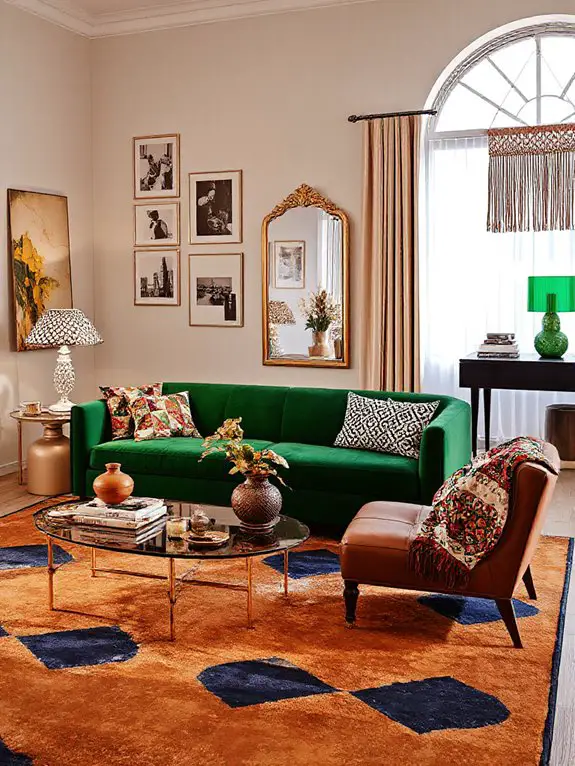
Eclectic interior design thrives on the unexpected, combining elements from various styles, periods, and cultures to create a space that’s uniquely personal. I love how it allows me to mix vintage furniture with modern art, or pair bold patterns with neutral tones, all while maintaining a cohesive look. The key is balance—too much variety can feel chaotic, so I focus on unifying elements like color palettes or textures.
I also enjoy integrating meaningful pieces, like a global souvenir or a family heirloom, to tell a story. It’s a style that celebrates individuality, encouraging creativity and self-expression in every corner.
Mediterranean
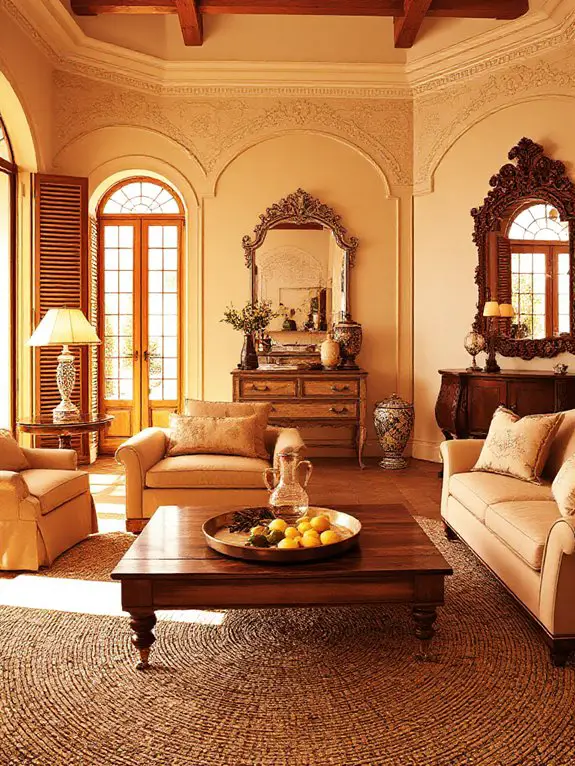
When I think of Mediterranean interior design, I’m immediately drawn to its warm, relaxed vibe that evokes the coastal regions of Greece, Italy, and Spain. It’s all about bringing the outdoors in, using natural materials like stone, wood, and terra-cotta.
I love how the color palette reflects the landscape—think earthy tones, deep blues, and warm whites. Arched doorways and wrought-iron accents add architectural charm, while textured fabrics like linen and cotton create coziness.
I’d recommend incorporating pottery, tile work, and lush greenery to complete the look. It’s a style that feels timeless and effortlessly inviting, perfect for creating a serene retreat.
Asian Zen
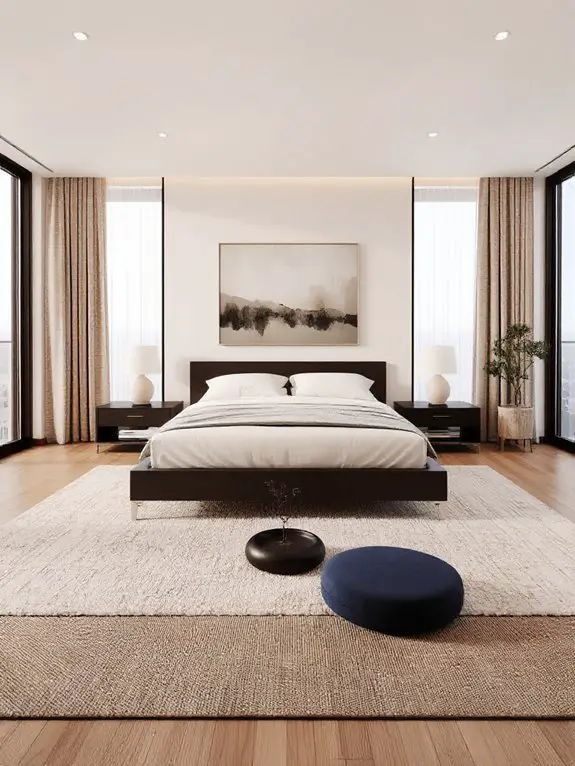
Asian Zen interior design embodies tranquility and simplicity, offering a serene escape from the chaos of daily life. I find it’s all about creating a harmonious space with clean lines, natural materials, and a neutral color palette.
Think bamboo, rice paper, and stone elements that bring the outdoors in. Incorporating minimalism is key—less clutter means more mental clarity.
I often suggest adding sliding doors or screens to separate spaces softly, maintaining an open, flowing feel. Lighting should be soft and indirect, mimicking natural light.
Finally, a few carefully chosen accents, like a bonsai tree or a water feature, can enhance the calming vibe.
French Country
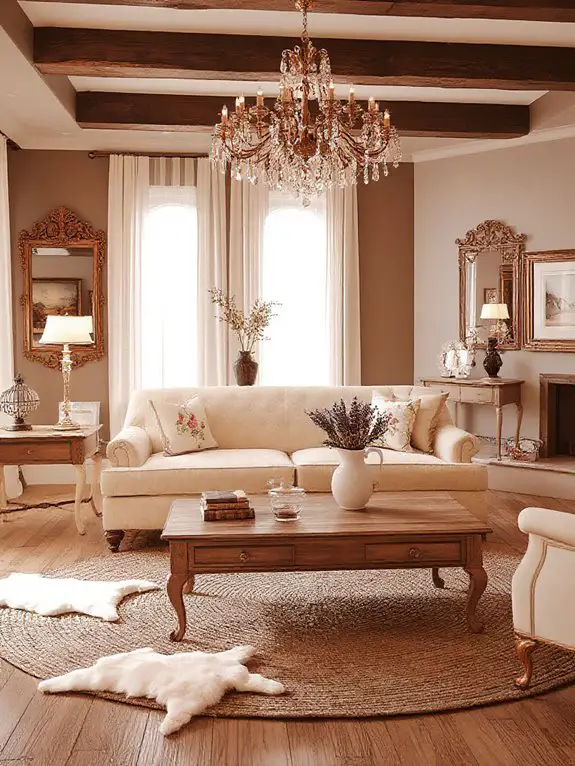
While French Country design often evokes images of rustic charm and timeless elegance, it’s also deeply rooted in practicality and comfort. I love how it blends natural materials like weathered wood and stone with soft, muted tones such as creams, blues, and sage greens.
To achieve this look, I focus on furniture with curved lines, vintage pieces, and distressed finishes—think farmhouse tables and upholstered armchairs. Textiles play a key role, too; I layer linen, cotton, and toile fabrics for warmth and texture.
Finally, I add touches like wrought iron accents, ceramic pottery, and fresh flowers to complete the effortless, inviting aesthetic.
Urban Modern
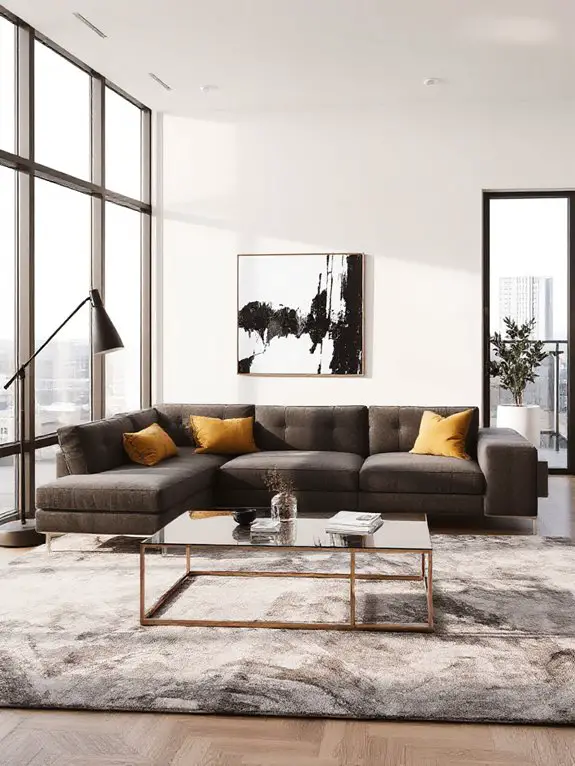
Urban Modern design embraces sleek lines, neutral palettes, and a minimalist approach, creating a polished yet functional space perfect for city living. I love how it combines industrial elements like exposed brick or metal accents with clean, contemporary furniture.
To achieve this look, I stick to a muted color scheme—think grays, whites, and blacks—and add texture with materials like leather, concrete, or wood. Lighting plays a key role; I opt for statement fixtures that double as art.
Storage is essential in small urban spaces, so I prioritize multifunctional furniture. Keep decor simple but intentional, focusing on a few standout pieces for impact.
Maximalist
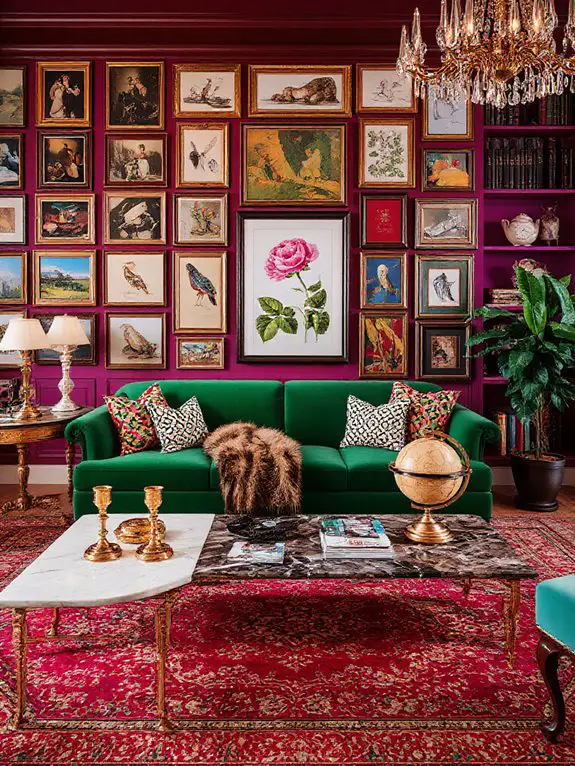
Though minimalism has dominated design trends for years, maximalism boldly embraces the opposite philosophy—more is more. I love how this style layers bold colors, intricate patterns, and eclectic decor to create a space bursting with personality.
Think rich textures, statement furniture, and walls adorned with art or wallpaper. It’s not about clutter but intentional excess—every piece tells a story. To pull it off, start with a cohesive color palette, then mix eras and styles confidently.
Balance is key; anchor the room with a focal point, like a vibrant rug or oversized lighting. Embrace the drama and let your space reflect your boldest self.
Hollywood Glam
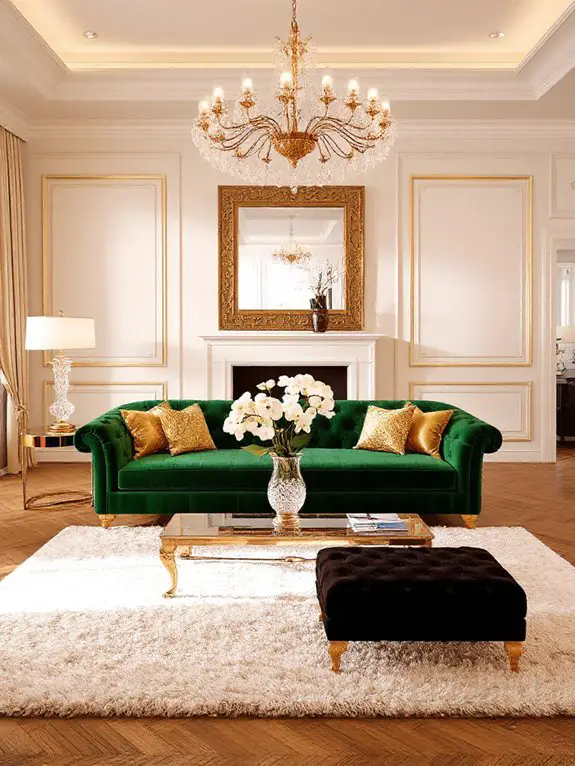
From the exuberance of maximalism, I shift to the polished allure of Hollywood Glam. This style captures the opulence of old Hollywood, blending luxury with sophistication.
Think plush velvets, mirrored surfaces, and metallic accents like gold or silver. I love how it balances drama with restraint—bold chandeliers, sleek furniture, and rich textures create a sense of grandeur without feeling overwhelming.
Incorporating black-and-white palettes with pops of color adds depth. For me, it’s about creating a space that feels elegant and timeless, like a star’s private retreat.
Hollywood Glam elevates everyday living into something cinematic and unforgettable.
Vintage
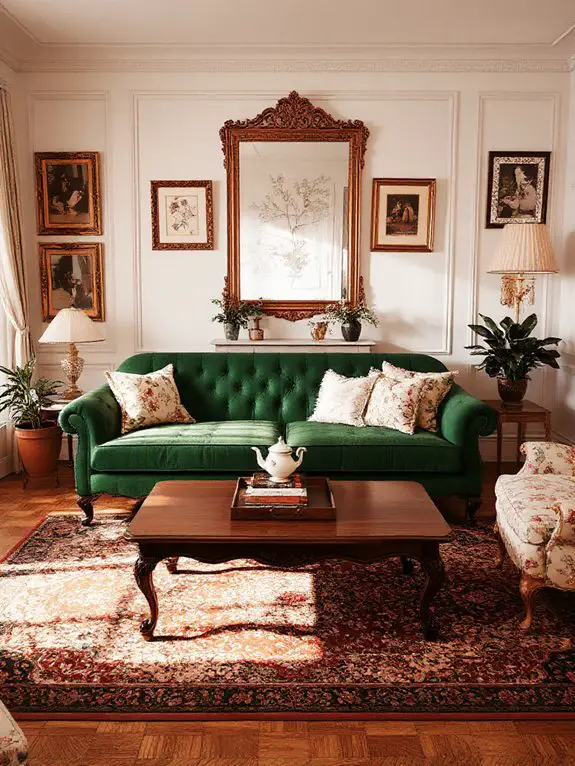
While many design styles embrace modernity, Vintage draws inspiration from the past, offering a timeless charm that feels both nostalgic and fresh. I love incorporating pieces from different eras—whether it’s a mid-century armchair, an Art Deco mirror, or a shabby chic dresser.
The key is to balance old and new so the space doesn’t feel like a museum. I mix vintage finds with contemporary elements, like pairing a retro rug with a sleek sofa.
Don’t shy away from imperfections—worn edges and patinas add character. Vintage isn’t just a style; it’s storytelling, weaving history into your home’s aesthetic.
Tropical
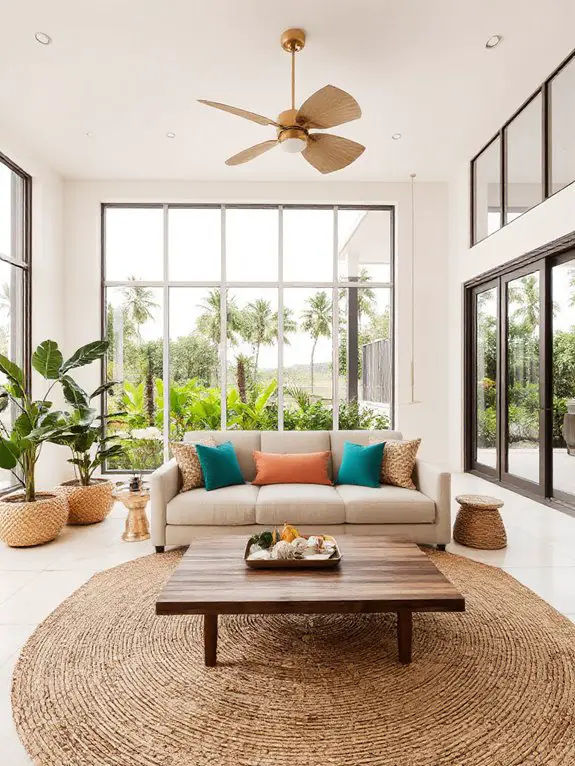
Tropical design brings the lush, vibrant energy of nature indoors, creating a space that feels both relaxing and invigorating. I love incorporating natural materials like rattan, bamboo, and wicker to evoke that laid-back island vibe.
Bold, leafy patterns on pillows or wallpapers instantly transport me to a tropical paradise. I keep the color palette fresh with greens, blues, and sunny yellows, accented by warm wooden tones.
Adding plants like palms or monstera deliciosa enhances the organic feel. I’ll often include woven textures and light, airy fabrics to guarantee the space feels breezy and open, just like a beachside retreat.
Industrial Chic
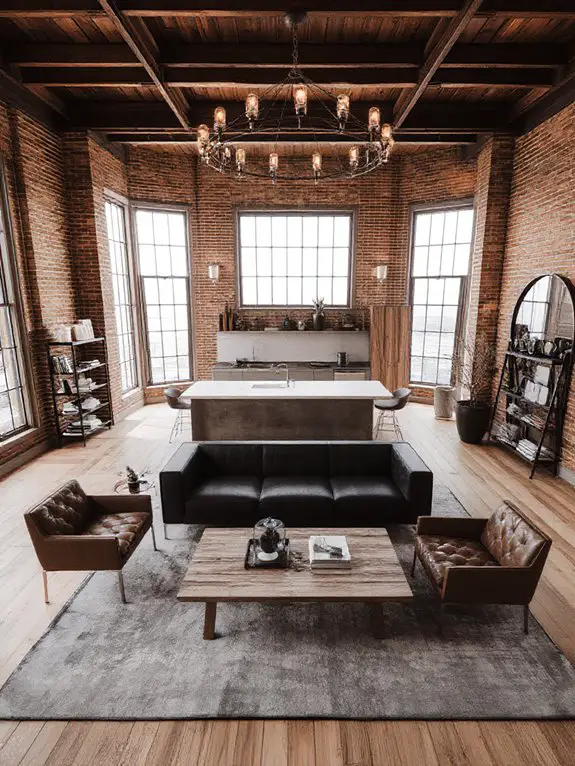
Industrial chic embraces raw, unfinished elements to create a space that’s both edgy and functional, blending the toughness of urban lofts with sleek modern touches. I love how it uses exposed brick, concrete floors, and metal beams to give a room character.
Open floor plans are key, allowing natural light to highlight textures. Furniture often features reclaimed wood or distressed leather, adding warmth to the rugged aesthetic.
Lighting plays a big role—think pendant lights with Edison bulbs or industrial sconces.
I keep décor minimal, using utilitarian objects like vintage factory carts or metal stools to maintain balance and authenticity.
Japandi
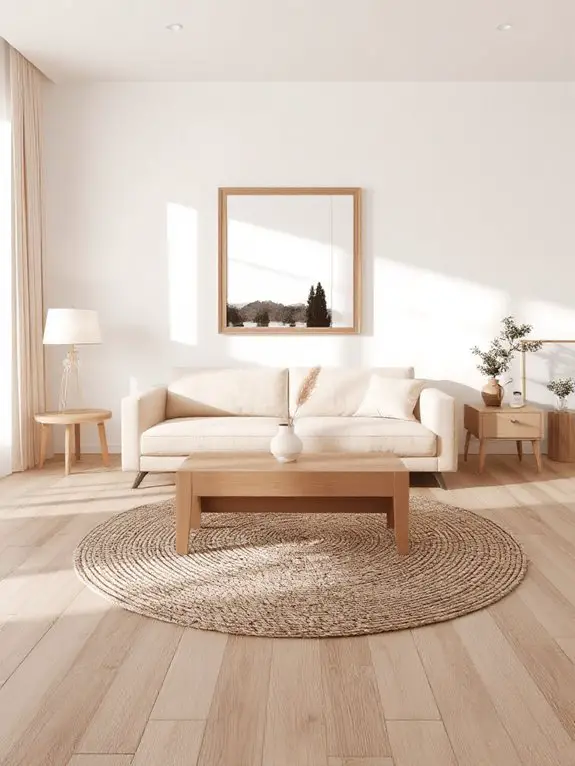
Japandi, a seamless fusion of Japanese minimalism and Scandinavian functionality, has quickly become one of my favorite interior design styles for creating serene, clutter-free spaces. I love how it combines the warmth of Scandinavian design with the simplicity and elegance of Japanese aesthetics.
Neutral color palettes, natural materials like wood and stone, and clean lines are its hallmarks. I always recommend incorporating soft textures, such as linen or wool, to add coziness without overwhelming the space.
Functionality is key—every piece should serve a purpose. Thoughtful lighting, like paper lanterns or minimalist fixtures, enhances the calm, inviting atmosphere that defines Japandi.
Frequently Asked Questions
How Do I Mix Different Design Styles Effectively?
I find blending styles is like weaving a tapestry—start with a neutral base, then layer in bold pieces that whisper rather than shout. Keep balance by repeating colors or textures, and let each piece tell its story.
What Are Budget-Friendly Tips for Redecorating?
I’ll start by decluttering and rearranging what I already own to refresh my space. I’ll shop secondhand or DIY decor to save money. Adding affordable touches like paint, new hardware, or plants can make a big difference.
How Do I Choose the Right Lighting for My Space?
I start by evaluating the room’s purpose and size. Ambient lighting sets the mood, task lighting focuses on functionality, and accent lighting highlights decor. I mix fixtures, like floor lamps and pendants, ensuring flexibility and balance.
What Are the Best Colors for Small Rooms?
Choosing colors for a small room is like painting a sunrise—light and airy hues stretch the space. I’d go for soft whites, pale blues, or muted greens; they’re mirrors that reflect openness and calm.
How Do I Incorporate Sustainability Into My Design?
I prioritize sustainable design by choosing eco-friendly materials like reclaimed wood or recycled textiles. I reduce waste by repurposing old furniture and opt for energy-efficient lighting. I also incorporate plants to improve air quality naturally.

